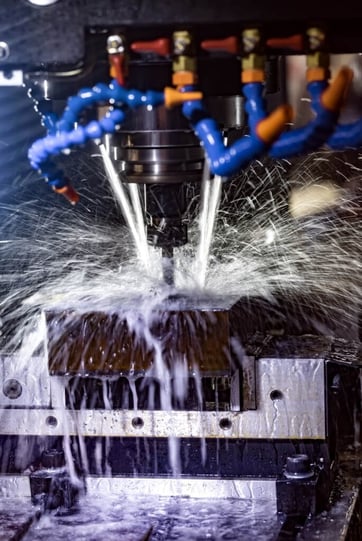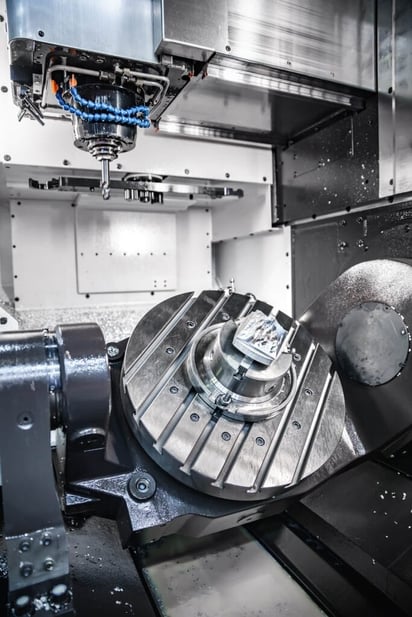CNC machining is an accurate and streamlined way to traditionally machine complicated parts. Did you know that some CNC machines are even more accurate and can handle more complex parts than others? It all boils down to how many axes they have. In this piece, we’ll teach you the difference between 3, 4, and 5-axis machining and which one is right for your application.
What is an Axis in Machining?
If you think back to your math days in school, you might remember what an axis is. Basically, it’s used to describe motion along a given path.
For example, a regular chart usually has an x and y-axis. If you plot how much money you spend on beer over time, you’ll be using something like this. Time moves with the x-axis, and beer money spend moves with the y-axis.
This same idea can be used on a CNC (computer numerical control) machine. CNC machines use computer software to control the motion of cutting tools around a part. In the old days, machinists would have to manually jog a machine and measure all the features by hand before cutting.
If you look at a CNC mill going to the left and right, we would call that the x-axis on the machine. Typically, motion to the left would be in the negative direction, and motion to the right is in the positive direction.
When Do the Axes Matter?
The axes are among the most important part of running a CNC machine. They are used in every single hole, cut, and feature that gets machined.
In fact, the first step of most projects is to “zero” the axes. This is a process of telling the machine where the material is to get the most accurate final product.
So, we established how vital axes are. The next step is to explain the difference between machines with 3, 4, and 5 axes.
What is 3-Axis Machining?
3-axis machines are a more traditional style of CNC mac

They’re also more commonly found on the shop floor and are the least intricate option on this list.
They can move left-to-right (x-axis), front-to-back (y-axis), and up and down (z-axis). Combining these three axes gives you the XYZ plane.
3-axis is the only style of machine on this list in which the material is stationary for the cutting operation. You clamp raw material into a vise and move the cutting head around it.
Although this is the simplest form of machining on this list, it’s still highly complex. The programming allows a skilled machinist to make some intricate parts as long as they know what they’re doing.
Uses for a 3-Axis Machine
-Drilling holes
-Machining slots
-Rounding corners
-Cutting simpler features and geometries
What is 4-Axis Machining?
Slap on another axis, and you get a 4-axis machine. In this case, you’re adding the A-axis. The A-axis rotates around the x-axis of the machine. Rotation away from the operator is considered the positive direction.
In most 4-axis CNC machines, the workpiece will be the part that rotates in the A-axis. In other words, the material that you clamped down can actually rotate while the machine is operating.
The impressive part of this added axis is that it can move in junction with other axes. The CNC machine can rotate a piece while drilling a slot, for instance.
This allows for much more complex parts to be made. The orchestration between the XYZA axes is fun to watch.
Uses for a 4-Axis Machine
-Cutting features on cylindrical or curved pieces
-Working along the side of material without manually rotating and re-zeroing the machine
-Continuous cutting
-Making multi-axis rounded features
What is 5-Axis Machining?

The final, and most complicated form of CNC machines on our list is the 5-axis machine. The added 5th axis can differ from machine to machine:
-Around the x-axis is the A-axis
-Around the y-axis is the B-axis
-Around the z-axis is the C-axis
A machine might offer XYZAB, XYZAC, or XYZBC. Most often, machines offer an XYZAB configuration.
Just like in 4-axis machining, the workpiece is typically the area that moves in these two extra axes.
As you can imagine, this allows for even more complicated parts to be made. It also allows for a fully autonomous process — the machinist doesn’t have to take a part out of the vise, rotate it, and put it back in since the cutting tool will move all around the piece.
This ultimately leads to quicker operational time.
Uses for a 5-Axis Machine
-High-accuracy pieces
-Faster turnarounds
-Making intricate parts
-Machining complex geometries and features
-Less operator interaction
The Difference Between 3, 4, and 5-Axis Machining
The more axes you add, the more accuracy you can achieve. In addition, the process becomes faster and opens the door for more complicated parts to be made on the machine. A high-quality machine shop will have all three options to help their customers better.
Conclusion
Knowing the difference between 3, 4, and 5-axis machines is the first step towards understanding which machine is right for you. At Rapid Axis, we have 3, 4, and 5-axis CNC machines on our shop floor. We have the machinery to help create the perfect products for your business. Contact us today to see how we can help and get a free quote.

